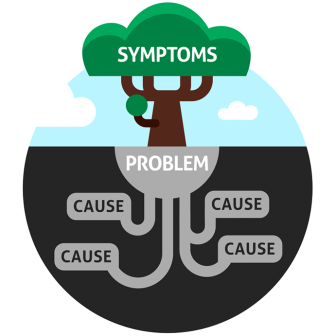Uh oh — so you’ve had an adverse risk event occur. A resident injury, an employee event, or some other unexpected outcome. And what’s worse, it’s not the first time. Ugh, you just addressed this, didn’t you? What went wrong?
How to Figure Out What Went Wrong
Often times we don’t take the time to dig down to the root of a problem and correct the root cause which will help prevent recurrence. Addressing root causes is different than addressing the symptom of a problem. When dealing with a recurring problem, you need to examine whether or not you’ve actually addressed the true cause of the issue. If the same issue is recurring, in all likelihood you’ve missed the mark and haven’t identified the root of the issue.
Time to dig deep! To find the actual cause, ask why until you’re satisfied that you’ve identified where the breakdown initially stemmed from. Ideally, this will reveal where the issues is stemming from on a root level, and you’ll be able to uncover a process breakdown and develop strategies to address. We’ll dive more into that later — first, let’s look at this commonly used example:
Problem: A mouse ate your cheese.
WHY: There’s a mouse in the house.
WHY: The screen door is open.
WHY: The spring latch is broken on the screen door.
If you only addressed the symptom by placing a mousetrap, you may succeed in eliminating the problem temporarily. However, without addressing the broken door latch, you leave the door open (so to speak) for the problem to reoccur. In this example, fixing the broken door latch is addressing the root of the problem. While clinical risk management is more complex and can involve many more levels of digging, minimizing risk is vital for both employee safety and resident recovery.
How to Minimize Risk Going Forward
Using Root Cause Analysis (RCA) is a common tool used in health care settings in a patient safety and quality improvement program. 
A thorough RCA includes three essential elements:
1) What happened: A clear understanding of what actually occurred, and an exhaustive analysis of event with focused attention to detail.
2) Why it happened: Dig deep and get to the root of the problem. Leave no stone unturned.
3) Action Planning: What are you going to do about it? Corrective action plans to address the root cause.
Stay tuned for how to develop and execute a strong action plan.
Lisa Chadwick, Director of Risk Management | Functional Pathways

Comments (0)